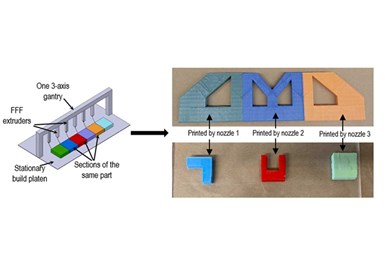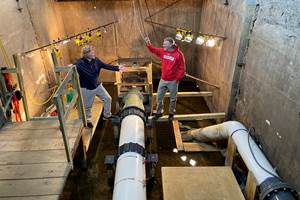Rutgers Engineers Create Faster, More Precise 3D Printing Process
Researchers says their Multiplexed Fused Filament Fabrication Process could be a game changer for the 3D printing industry.
By programming a prototype to move in efficient patterns and by using a series of small nozzles to deposit molten material, researchers say they were able to increase printing resolution and size as well as significantly decrease printing time. Photo Credit: Rutgers School of Engineering
Rutgers engineers says they have created a way to 3D print large, complex parts at a fraction of the cost of current methods.
“We have more tests to run to understand the strength and geometric potential of the parts we can make, but as long as those elements are there, we believe this could be a game changer for the industry,” says Jeremy Cleeman, a graduate student researcher at the Rutgers School of Engineering and the lead author of the study.
The approach is called Multiplexed Fused Filament Fabrication (MF3), which uses a single gantry (the sliding structure on a 3D printer) to print individual or multiple parts simultaneously. By programming a prototype to move in efficient patterns and by using a series of small nozzles — rather than a single large nozzle, as is common in conventional printing — to deposit molten material, the researchers say they were able to increase printing resolution and size as well as significantly decrease printing time.
“MF3 will change how thermoplastic printing is done,” Cleeman says.
According to the researchers, the 3D-printing industry has struggled with what is known as the throughput resolution tradeoff — the speed at which 3D printers deposit material versus the resolution of the finished product. It is said larger diameter nozzles are faster than smaller ones but may generate more ridges and contours that must be smoothed out later, adding significant postproduction costs.
By contrast, smaller nozzles deposit material with greater resolution, but researchers say current methods with conventional software are too slow to be cost effective.
At the heart of MF3’s innovation is its software. To program a 3D printer, engineers use a software tool called a slicer — computer code that maps an object into the virtual “slices” or layers that will be printed. Rutgers researchers wrote slicer software they say optimized the gantry arm’s movement and determined when the nozzles should be turned on and off to achieve the highest efficiency. MF3’s toolpath strategy makes it possible to “concurrently print multiple, geometrically distinct, noncontiguous parts of varying sizes” using a single printer, the researchers wrote in their study.
Cleeman said he sees numerous benefits to this technology. For one, the hardware used in MF3 can be purchased off the shelf and doesn’t need to be customized, making potential adoption easier.
Additionally, because the nozzles can be turned on and off independently, an MF3 printer has built-in resiliency, making it less prone to costly downtime, Cleeman adds. For instance, when a nozzle fails in a conventional printer, the printing process must be halted. In MF3 printing, the work of a malfunctioning nozzle can be assumed by another nozzle on the same arm.
As 3D printing increases in popularity — for manufacturing and particularly for the prototyping of new products — resolving the throughput resolution trade-off is essential, Cleeman says, adding that MF3 is a major contribution to this effort.
Related Content
What Does Additive Manufacturing Readiness Look Like?
The promise of distributed manufacturing is alluring, but to get there AM first needs to master scale production. GKN Additive’s Michigan facility illustrates what the journey might look like.
Read MoreHow to Build 10,000+ Shot Molds in Hours
Rapid tooling isn’t so rapid when it takes days to 3D print a metal mold, and then you still must machine it to reach the necessary tolerances. With Nexa3D’s polymer process you can print a mold in hours that is prototype or production ready and can last for more than 10,000 shots.
Read MoreHow Large-Format 3D Printing Supports Micro-Scale Hydropower
There is potential hydroelectric power that has never been unlocked because of the difficulty in capturing it. At Cadens, additive manufacturing is the key to customizing micro-scale water turbine systems to generate electricity from smaller dams and waterways.
Read MoreLarge-Format “Cold” 3D Printing With Polypropylene and Polyethylene
Israeli startup Largix has developed a production solution that can 3D print PP and PE without melting them. Its first test? Custom tanks for chemical storage.
Read MoreRead Next
Hybrid Additive Manufacturing Machine Tools Continue to Make Gains (Includes Video)
The hybrid machine tool is an idea that continues to advance. Two important developments of recent years expand the possibilities for this platform.
Read More4 Ways the Education and Training Challenge Is Different for Additive Manufacturing
The advance of additive manufacturing means we need more professionals educated in AM technology.
Read More3D Printing Brings Sustainability, Accessibility to Glass Manufacturing
Australian startup Maple Glass Printing has developed a process for extruding glass into artwork, lab implements and architectural elements. Along the way, the company has also found more efficient ways of recycling this material.
Read More























